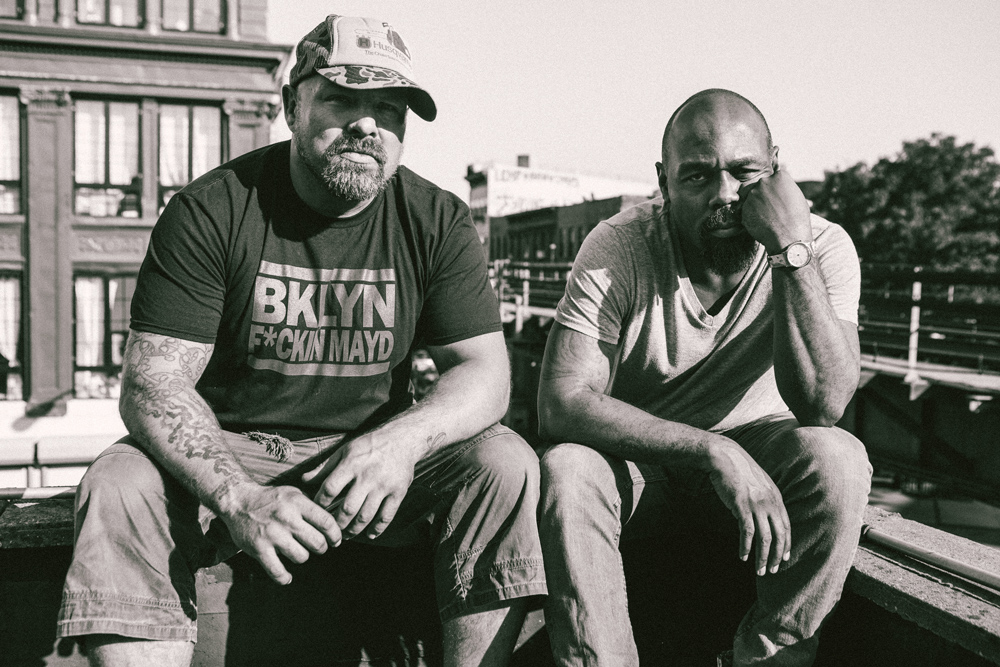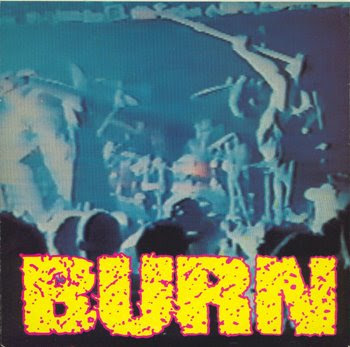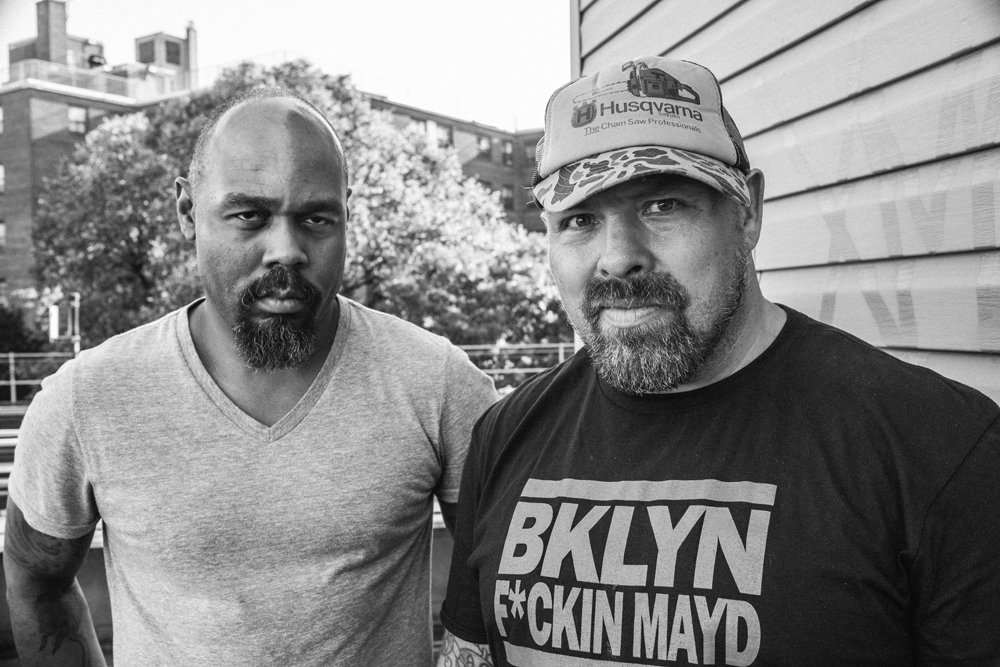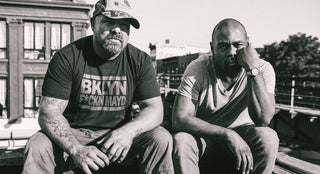“Even watching Burn set up their gear would give you that fucked up, drug-like euphoria coursing through your body. Violent, beautiful, musically and emotionally—it truly captured the rhythm of what was going on in the streets of downtown NYC during those years. We would all talk about music, all of the time. Chaka had his dad’s jazz record collection at our apartment. Chaka, Gavin, Alan Cage and I all lived there. We would listen to those records one-by-one and get inspired, then walk outside and watch the sun set over the Williamsburg Bridge. It all became the type of weird hardcore we wanted to play.” -Mark Ryan (Supertouch)
The start of a Burn live set is a blast of psychic energy. Unlike most hardcore bands, Burn’s momentum isn’t contingent upon speed, instead hinging on dynamics and pacing. When they debuted in 1989, New York City’s hardcore scene had stretched past its primal roots. Bands had crossed over into thrash, speed metal, hip-hop, hard rock, and even psychedelia. As hardcore’s formula hit its ceiling in the mid-’80s, it made sense that bands looked to expand their sound and audience.
Like many of their peers, Burn were looking to tap into something new. What made them stand out was a sound rooted in the identifiers of hardcore, simultaneously pulling those threads apart and lighting them on fire. With many of their songs menacing along slowly and employing a variety of slower tempos, some labeled Burn as part of the emerging post-hardcore scene in New York, along with labelmates on Revelation Records, Quicksand and Supertouch. But for as much groove in Burn’s material, their songs also tapped the speed and stomp of Discharge and the Cro-Mags—a foot in two worlds, standing confidently above both. That conflict was only heightened in their later records, and is evident when they play shows now.
Having played in the NY Hoods, Side by Side, and Absolution prior to Burn, guitarist Gavin Van Vlack was a veteran presence, known for his signature riffs. Despite Absolution’s popularity, he was ready to find a new noise.
“Absolution always wanted to do something different, but it was never the same different—my head was in a completely different place than the other members,” Van Vlack said. “Chaka expressed interest in doing a band and I really appreciated fresh input. He was into a lot of different things that no one else was listening to; he was the first one to turn me onto Jingo de Lunch.”

One of Absolution’s most defining tracks, “Never Ending Game,” appeared on a tape compilation released by Queens native Chaka Malik and friend Freddy Alva. Dubbed cassette-by-cassette on a boombox, The New Breed compilation was released in a one-time edition of 700 in 1989. The cult comp featured several New York-area bands, including Raw Deal, Breakdown, Uppercut, Outburst, and Life’s Blood, would continue on to actively define NYHC’s next injection of adrenaline.
Two other bands on the tape comp also proved to be key to Burn’s expansive sound. Alan Cage, Beyond’s drummer, and Alex Napack, who played bass for Pressure Release, would fill Burn’s rhythm section. Cage’s drumming with Beyond showed he had the control to handle any tempo and the poise to anchor any song with an almost Bonham-esque swing and thud. Napack’s bass skills came to the forefront of Pressure Release’s material, who moved from the construct of straight edge hardcore into darker territory on their Prison of My Own 7″.
With their lineup solidified, the band ventured from their respective boroughs, away from the Lower East Side, where most of the matinees were hosted at CBGB and the Pyramid Club, over the bridge into Williamsburg, Brooklyn was then more barren and as unpredictable as the LES.
“[BACK THEN] IT WAS SO LAWLESS, THAT YOU COULD REALLY DO ANYTHING.” -GAVIN VAN VLACK
Isolated among the industrial waterfront, Burn took residence in South Williamsburg, a decade before the L train ran on anything resembling a schedule and ahead of any clichés about the neighborhood as epicenter of lazy cool. During the ’80s, the area was rife enough with gang activity to be dubbed “The Killing Fields” by community leader Luis Garden Acosta. Still, Williamsburg just one stop away from the LES by train, and it drew creatives seeking more space and lower rent, along with a band searching for sound.
“It was really adventurous back then—I’m not talking the late-’90s, I’m talking ’89-’91,” Van Vlack said. “It was so lawless, that you could really do anything.”
Environment has always been a key in the music created in New York. The cross-pollination of natives and transplants, creatives and capitalists, and an omnipresent tension fueled mixed-up sounds. As Burn’s sound formed, it was obvious there was as much feeling as there was force being channeled.
“The bass lines were really droning; it’s almost like a Jaco Pastorius approach—the bass really stands on its own,” said Malik. Napack’s brooding bassline in “Drown” was “like listening to Joni Mitchell’s ‘Hejira,’” said Malik. “The bass really takes you places and gives you a mood—a place to live emotionally. When he brought in ‘Drown,’ it was written out as a complete bassline. Everything was added on top, to complement it.”
Nothing about Burn has ever been typical. Rather than sticking to bills specific to their genre, they’d stretch out to share the stage with crusty punks of Nausea or Born Against, who famously took Sick of it All and Killing Time to task for signing to larger labels. But was it strategy or necessity?
“It was a lack of calculation more than anything,” Van Vlack said. “One of my favorite things is playing live, because there’s nothing that feels like that—it’s unparalleled. So, to be like, ‘I don’t wanna play here,’ or, ‘I don’t want to play with that band’... I just don’t get that.”
Whether it was CBGB, suburban Connecticut, or counter culture social center ABC No Rio, they brought the same intensity. “We played this place [called] the Lizard’s Tail, that was a weird little bar that was down the block from us when we lived on South 6th Street and Berry,” Van Vlack said. “It was opened up during the whole wake of the Baker Beach, Burning Man thing. They were responsible for a lot of weekend long warehouse parties. The place was tiny, the stage less than a foot tall, but it was a great show.”
They constantly played along the East Coast, eventually headlining clubs to hundreds of people on the strength of one 7″. But regardless of their cavalier attitude about who they played to, Burn experienced obstacles that the average band never faced.
“We rolled up and were selling shirts and people were hanging out with us,” Malik recalled of a show at the Airport Music Hall in Allentown, Pennsylvania. “We noticed a guy with a National Front patch, then a guy with a Skrewdriver shirt, then, ‘Yo, is that dude wearing a Brutal Attack shirt?’ Then we realized that out of the 500 or so people, there were at least 100 that were Nazis.
As the band played, the stage was surrounded by Nazi skinheads, sieg heiling, with things quickly becoming violent.
“I remember that Chris and Dave from Vision had taken any mic stand that wasn’t being used, and broke then down to club length,” Van Vlack said. ”Our best shows are when the audience is really into it, but they were into it for much different reasons that night.”
The Allentown, PA, show where 1/5 of Burn’s audience that night were Nazis.
As the scene was transitioning, a string of releases on Revelation Records refuted the idea that hardcore was entering a malaise in 1990. Along with Burn, Supertouch, Shelter, Inside Out, and Quicksand’s records gripped listeners with progressive sounds and fresh takes. Coincidentally, it was in the basement of Burn’s apartment, where Supertouch and Quicksand also rehearsed for a period of time.
“When our first record came out, some dismissed it as being overtly metal, which of anything we listened to, metal was what we were into the least,” Van Vlack said. Crunch and thick production could be considered on the metallic side of things for some punk purists, yet Burn’s debut seemed to immediately be embraced. It captured a moment, but didn’t borrow from any time.
Starting with a drum roll, followed by Malik’s growl, “...Shall Be Judged,” put everyone on notice. Burn may have not been the first band to address animal rights, but they did it in a way that had never been done. Malik spins a sermon about the dangers of consumption, while the brand drives. The song ends in a throbbing cascade of sound, with swirling refrain of “We have killed and shall be judged,” delivered with a controlled cool.
Even the EP’s sleeve was atypical: No posed band shot, skulls, or shirtless moshing men. Instead, the obscured image, concepted by Malik, proved to be a bolder statement.
“I grew up with Art Forum magazines around the house,” Malik said. “The magazines back then were beautiful, like Interview. The front cover came from... there was a video cassette I had of some live band I was watching and someone called my name, so I paused the VHS tape. Right when I paused it, someone was taking a flash picture, so it captured that really concentrated, positive/negative thing. I had Sacha Jenkins video our show at the Anthrax, with the intention of freezing it as a flash went off, then have my dad shoot a still of the screen.”
“We used interesting colors,” he said. “I think it looks like candy to a degree, especially on pink vinyl—It looked sort of edible.”

Burn EP cover art.
With fans hungry for more, Howie Abrams, then A&R for Roadrunner Records, had Burn demo material 1992, later released on Revelation Records in 2002 as the Last Great Sea EP. Unfortunately, Abrams wasn’t able to leverage the Don Fury produced demo into any opportunities.
“I liked the demo, but it was hard rallying other folks at Roadrunner around the band. The music was adventurous and non-formulaic, and most there were used to peddling Obituary records,” Abrams said. “The band seemed to be in a strange place as well.”
“I’m very impulsive,” Van Vlack said. “At a certain point, I would point a gun at my foot and squeeze the trigger. When we broke up, things were going fairly well, but there was tension and back communication between Chaka and I. At that point, we didn’t really have the tools to express what was happening. I just threw my hands up and walked away.”
Van Vlack shot Burn dead, quickly forming the noise rock outfit Die 116, while Malik rebounded with Orange 9mm, who released an EP on Revelation in 1994, before securing a major label contract with East West. Both bands may have had elements of Burn, with Die 116, but neither tapped into that collective, unspoken power.
Some bands overstay their welcome, but no one wanted Burn to stop, so when they briefly returned in 1998, there was as much energy around them as ever. They’d continue through different periods of activity, recording an EP in 2001 for Equal Vision Records titled Cleanse, with Vic DiCara (Beyond, Inside Out, 108) on second guitar and Manny Carrero (Glassjaw) on bass. Despite the material, the demand, and the performance, Burn again went dormant.
“IF [THE AUDIENCE] CAN GET TO A HIGHER VIBRATION, THERE’S A BETTER CHANCE THEY CAN USE THEIR CRITICAL THINKING SKILLS” -CHAKA MALIK
With a reunion as a perpetual rumor, Burn announced early in 2015 this year that they’d headline the Black ‘N Blue Bowl in New York City. With Malik and Van Vlack in sync, Glassjaw drummer Durijah Lang was brought in to shore up the rhythm section with Carrero, instantly capturing the right feel for the material. They quickly proved that their return to the stage was more than playing their songs to eager fans, but a connection to the force of what you can’t see—the actual power of sound.
“One of the things that can help you learn is excitement,” Malik said. “Regardless of whether or not the audience hears every lyric or understands the songs, if they can get to a higher vibration, there’s a better chance they can use their critical thinking skills—you have more [of] a desire to be better for yourself, your family, and friends.”
Burn have returned invigorated and inspired, booking their first West Coast and European dates, speaking of the possibility of recording old and new material, and most importantly, harnessing the potential they’ve always channeled so naturally.
“The only thing I had planned was to tell the crowd that every band on the bill could be headlining—after that, there was no thought at all,” Malik said. “I’ve heard this thing about saxophone players, who get circular breathing when they play. Something happens, where they’re able to breathe continually while playing. You feel supported. You don’t have to think.”
So, 25 years after Burn’s debut, what’s it like to play again, to a scene that’s grown to a size unimaginable when the first NYC bands stormed the Bowery?
“It feels the same to me,” Malik said. “Is that weird?”
***

Follow Burn on Facebook. Tour dates below:
October 4 (Saturday): London, UK. TICKETS.
October 9 (Friday): Constellation Room at the Observatory, Santa Ana, CA. TICKETS.
October 10 (Saturday): 924 Gilman, Berkeley, CA, US. TICKETS.
October 11 (Sunday): El Rey Theatre, Los Angeles, CA, US. TICKETS.
Photos by Jammi York.

